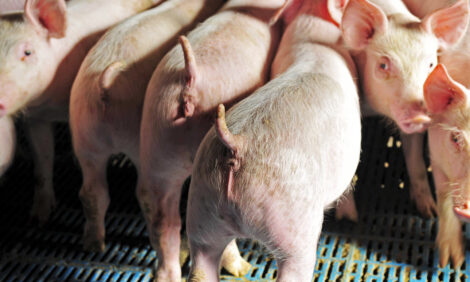



Phages Show Potential for Salmonella Control
US - Bacteriophages ('phages') – viruses that prey on foodborne-disease causing bacteria such as Salmonella – show potential to be used in a food safety pathogen reduction strategy in pigs, according to new research.Todd R. Callaway from the Food and Feed Safety Research Unit, ARS/USDA at College Station in Texas and co-workers have investigated the occurrence of Salmonella-specific bacteriophages in pig faeces collected from commercial farms. Their paper is due to be published soon in the journal, Foodborne Pathogens and Disease. Phages could potentially be used as a food safety pathogen reduction strategy in pigs, they conclude.
Salmonella is one of the leading causes of human foodborne illness and is associated with swine production, explain Callaway and co-authors. Bacteriophages are naturally occurring viruses that prey on bacteria and have been suggested as a potential intervention strategy to reduce Salmonella levels in food animals on the farm and in the lairage period. If phages are to be used to improve food safety, then it in important to understand the incidence and natural ecology of both phages and their hosts in the intestinal environment.
The study investigates the incidence of phages that are active against Salmonella spp. in the faeces of commercial finishing pigs.
Faecal samples (n=60) were collected from each of 10 commercial swine finishing operations. Samples were collected from 10 randomly selected pens throughout each operation; a total of 600 faecal samples were collected.
Salmonella spp. were found in 7.3 per cent (44/600) of the faecal samples.
Bacteriophages were isolated from faecal samples through two parallel methods: (1) initial enrichment in Salmonella Typhimurium; (2) initial enrichment in Escherichia coli B (an indicator strain), followed by direct spot testing against Salmonella Typhimurium.
Bacteriophages active against Salmonella Typhimurium were isolated from one per cent (6/600) of the individual faecal samples when initially enriched in Salmonella Typhimurium, but E. coli B-killing phages were isolated from 48.3 per cent (290/600) of the faecal samples and only two of these phages infected Salmonella Typhimurium on secondary plating.
Collectively, Callaway and co-authors conclude their results indicate that bacteriophages are widespread in commercial swine but those capable of killing Salmonella Typhimurium may be present at relatively low population levels.
They add that phages (predator) populations may vary along with Salmonella (prey) populations, and that phages could potentially be used as a food safety pathogen reduction strategy in pigs.
Reference
Callaway T.R., T.S. Edrington, A. Brabban, E. Kutter, L. Karriker, C. Stahl, E. Wagstrom, R.C. Anderson, K. Genovese, J. McReynolds, R. Harvey and D.J. Nisbet. 2010. Occurrence of Salmonella-specific bacteriophages in swine feces collected from commercial farms. Foodborne Pathogens and Disease. doi:10.1089/fpd.2009.0512.






